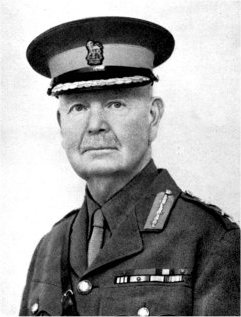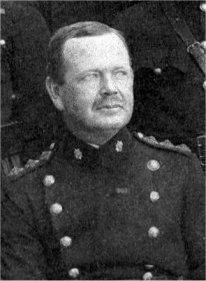Brig.-General George William St. George GROGAN, V.C., C.B., C.M.G., D.S.O.
Commanded the 2nd Battalion Worcestershire Regiment from December 1914 to January 1915.
Commanded the 1st Battalion Worcestershire Regiment from March 1915 to March 1917.
Commanded the 4th Battalion Worcestershire Regiment from January 1920 to February 1920.
Commanded the 3rd Battalion Worcestershire Regiment from February 1920 to January 1923.
George William St. George Grogan was born at St. Andrews, Fifeshire on the 1st September 1875. Of Irish descent he was the eldest of the five sons of Brigadier-General E. G. Grogan, who commanded the 1st Black Watch in the South African War. He was educated at the United Services College at Westward Ho before passing into Sandhurst. He received his commission in the West India Regiment in 1896. He saw some active service on the West Coast of Africa in 1898-99, first in the Sierra Leone expedition and then in the Lagos hinterland. Promoted captain in 1900 he was employed with the Egyptian Army from 1902 for five years. In 1907 he transferred to The King's Own Yorkshire Light Infantry, and in 1908 to The Worcestershire Regiment. At the beginning of the First World War he was in Egypt with the 1st Battalion Worcestershire Regiment, which came home to serve in the 8th Division. He got his majority in September 1914 and went to France to join the 2nd Battalion in the 2nd Division. In December 1914, while in the trenches in Flanders, he succeeded to command, but a week later, on January 6th, 1915 he was wounded. He then rejoined the 1st Battalion Worcestershire Regiment, which he was appointed to command in March 1915, after the battle of Neuve Chapelle. He fought on the Somme in 1916, and at the successful attack east of Bouchavesnes in March, 1917, he won the D.S.O. for his bold and capable leadership, being then given command of the 23rd Brigade in the 8th Division. |
Brig.-Gen. G. W. St. G. Grogan |
He led his brigade at Bellewaarde Ridge on the opening day of "Third Ypres " and during the German offensive in March 1918, in the severe engagements upon the Somme, and in the fighting retreat from the river line. At the end of the month at Moreuil, next to the French, he commanded all the surviving infantry of the 8th Division, and for his services throughout these critical days he was awarded a bar to his D.S.O. Then, after being engaged at Villers Bretonneux in April 1918, came the move to the Chemin des Dames front under the French. Here, when the Germans attacked on May 27th, the 8th Division spent itself in a gallant resistance, he rallied such troops as he could at Le Platrerie, south of the Aisne. He led them back to Roucy and then prepared a new line of defence at Jonchery, along the river Vesle. At Bouleuse ridge on May 28th, he rallied a mixed force of French and British by riding along the front under a heavy fire of all arms. His horse was killed, but he mounted another, and his great bravery undoubtedly saved the day in this part of the field, so that it was most fitting that he should be awarded the Victoria Cross. Throughout the battle his bouyant spirits and remarkable physical endurance had a heartening effect upon all with whom he came in contact.
The citation for his Victoria Cross, the last of the nine Victoria Crosses awarded to date to any officer or man of The Regiment, reads as follows :
"For most conspicuous bravery and leadership throughout three days of intense fighting (on the R. Aisne in May 1918). His action during the whole of the battle can only be described as magnificent. The utter disregard for his personal safety, combined with the sound practical ability which he displayed, materially helped to stay the onward thrust of the enemy masses."
In the advance to victory he led the 23rd Brigade towards Douai. During October, 1918 he captured Greenland Hill east of Arras and effected the passage of the Scarpe at the head of his leading troops.
After the Armistice he was selected for service in north Russia, assuming command of the 1st Brigade of the Relief Force which went out under Lord Rawlinson to accomplish the evacuation of the Archangel and Murmansk fronts. His services in the war were mentioned six times in dispatches, he was promoted brevet Lieutenant-Colonel in January 1917, and he was created C.M.G. in 1916 and C.B. in 1919.
He was promoted Lieutenant-Colonel and early in 1920 he commanded the 4th Battalion Worcestershire Regiment for a short time before going to India to take command of the 3rd Battalion Worcestershire Regiment in February 1920, and in April that year he received another brevet and was appointed A.D.C. to his Majesty. In 1923 he brought his battalion home from India preparatory to disbandment, and in October of that year he reached the substantive rank of Colonel and went to Aldershot to command the 5th Brigade of the 2nd Division. He retired from the Army with the honorary rank of Brigadier-General in 1926. From 1933 to 1945 he was appointed one of His Majesty's Bodyguard of the Honorable Corps of Gentlemen at Arms. In November 1938, he was appointed Colonel of The Worcestershire Regiment. A position he held until end of August 1945. He married Ethel Gladys, eldest daughter of John Elger, in 1920 and by her he had two sons. Brigadier-General George Grogan died at his home "Silverdene," Sunningdale, Berkshire, on the 3rd January 1962, at the age of 86. His furneral was held at the Woking Crematorium, Surrey, on 8th January, 1962. Lieut.-Colonel C. P. Vaughan represented the Colonel of the Regiment at his funeral. In his obituary in the 'FIRM' the Regiment Magazine, General Sir Richard Gale wrote: "I had the privilege of serving in the 3rd Battalion in Fyzabad, India in 1921 when General Grogan was Commanding. 'Grogy' as he was known to us, was an outstanding soldier. With a quiet, almost shy manner, it was sometimes hard to believe that he was such a valiant man; this was until and unless you raised his ire. The first sign then would be that he would scratch the back of his neck, after which anything might happen. Once, I saw the Regimental Contractor almost literally being kicked out of the C.O.'s office, with 'Grogy' waving a rotten banana at him, saying 'That'll teach you to sell this rotten stuff to my soldiers.' |
As a Captain in Egypt (1914) |
At the time he commanded we received a new stand of Colours from the Prince of Wales. Bertie Rance and I carried the Old Colours and the late John Milner and 'Bishop' Dodd received the New. This was shortly after the War, and very few knew anything about the detail of 'trooping.' Morning after morning would we rehearse, and because 'Grogy' meant it to be a first class parade, it was so.
He was a great student and he made us study our text books. From such a great fighting soldier it was, for us, a fine example, and we learnt what the study of one's profession really meant.
He set a pace and set a standard which made the Old 3rd one of the finest battalions in the British Army.
He was a great soldier, a great Commanding Officer, and a great gentleman."


